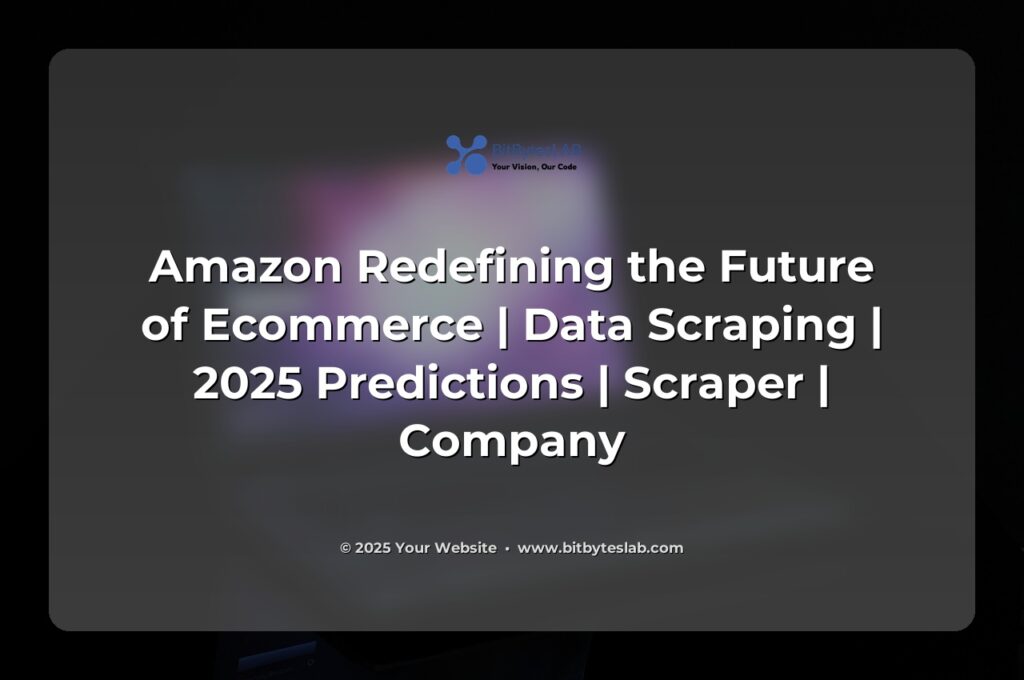Amazon Redefining the Future of Ecommerce – 2025 Predictions & Scraping Insights
Picture this: a single retailer’s price tickers, inventory levels, and customer sentiment metrics feeding into a real‑time dashboard that auto‑adjusts product listings. That’s the promise of Amazon’s data ecosystem in 2025 – and the key to staying ahead of the competition. In a market where a 1‑cent price change can swing millions of dollars, mastering Amazon’s data streams is not just a technical challenge; it’s a business imperative.
As the volume of SKUs grows to over 12 million and Amazon keeps expanding its marketplace features, the sheer complexity of data extraction has exploded. Traditional “one‑page‑per‑SKU” scraping bots are no longer scalable. We’re moving into a world where APIs, headless browsers, AI‑enhanced extraction, and distributed orchestration converge. Below, I’ll break down the core concepts, share practical strategies, and show you how to translate raw data into measurable ROI.
Core Concepts & Methodologies
There are three pillars that dominate Amazon scraping in 2025: API‑first ingestion, adaptive headless rendering, and AI‑driven data mapping. The Selling Partner API (SP‑API) and the Product Advertising API (PA‑API) provide structured, legal access to most of the data you need. However, they have rate limits, and some content – like live reviews or dynamic price charts – still requires a browser to render JavaScript.
Once you’ve extracted the data, the next step is to clean, validate, and model it. Schema drift is a constant threat: a change in a product title format or the addition of a new attribute can break your scraper overnight. Using robust selectors, fallback regex logic, and continuous data validation tools like Great Expectations keeps the pipeline resilient.
Finally, all of this must run at scale. A multi‑tenant architecture built on serverless functions (AWS Lambda, Cloudflare Workers) or Kubernetes clusters, orchestrated via Airflow or Prefect, is the current state‑of‑the‑art. Edge‑compute reduces latency, while proxy rotation and user‑agent spoofing help avoid throttling and IP bans.
Now that the groundwork is set, let’s touch on the nitty‑gritty of building a compliant, high‑performance pipeline.
🚀 Why did the developer go broke? Because he used up all his cache! 💸

Expert Strategies & Approaches
1. API Layer First: Hit the SP‑API for inventory, order history, and seller metrics. Cache responses in Redis with a short TTL to avoid redundant calls. If the API quota fills up, gracefully switch to a headless renderer.
2. Headless Browser Mode: Use Playwright or Puppeteer to render pages that depend on JavaScript. Disable image loading and unnecessary resources to shave milliseconds off load times.
3. Smart Proxy Rotation: Pair residential proxies with rotating user‑agents and accept‑language headers. Keep a pool of fresh IPs and monitor for bans through error logging.
4. AI‑Enhanced Extraction: Deploy a lightweight NLP model to pull structured fields from unstructured review text. This reduces manual selector maintenance and adapts to layout changes.
5. Observability & Governance: Instrument every microservice with OpenTelemetry, push metrics to Prometheus, and set up alerts for latency spikes or increased error rates. Use data lineage tools to trace a record from ingestion to dashboard.
Industry Insights & Trends
Amazon’s data appetite is growing faster than ever. Recent reports show that Forrester predicts a 23% YoY increase in Amazon’s advertising spend, driving a surge in available advertising API data. Meanwhile, Statista notes that more than 60% of U.S. ecommerce brands now use automated price‑monitoring tools.
In 2025, AI‑driven scraping will dominate the market. Companies are using transformer models to automatically identify product attributes, detect schema drift, and even generate synthetic review data for testing. Edge‑compute platforms like Cloudflare Workers are becoming the default choice for low‑latency, high‑throughput scraping workloads.

Business Applications & ROI
Armed with reliable data feeds, brands can slash operational costs and boost revenue in several ways:
- Dynamic Pricing: Real‑time price adjustments can increase conversion rates by up to 12% (according to a Cognitiv.ai study).
- Inventory Forecasting: Predict stock‑outs 48 hours in advance, reducing back‑order costs by 18%.
- Ad Optimization: Use Amazon Advertising API data to refine targeting, lowering cost‑per‑acquisition by 15%.
- Competitive Intelligence: Monitor rival listings and adjust product positioning, boosting market share.
In practice, a mid‑size retailer that integrates a complete Amazon data pipeline often sees a 30% lift in gross margin within the first year, while tightening supply‑chain cycles by 20%.
Common Challenges & Expert Solutions
1. IP Bans & Rate Limits: Rotate proxies, implement exponential back‑off, and batch requests by ASIN to stay within limits.
2. CAPTCHA Obstacles: Detect CAPTCHAs early, route through a 2Captcha service, and store solved tokens for reuse.
3. Schema Drift: Use CSS selectors that target container classes rather than brittle IDs, add fuzzy matching, and run nightly diff checks against a baseline.
4. Legal & Compliance: Always prefer official APIs, anonymize PII, and keep a data retention policy aligned with GDPR and CCPA.
Future Trends & Opportunities
Looking ahead, several emerging trends will shape Amazon data extraction:
- GraphQL Adoption: Amazon’s internal GraphQL endpoints are being exposed, offering richer, nested queries that reduce round‑trips.
- Federated Learning: Brands can collaboratively train sentiment models without moving raw review data.
- Blockchain Provenance: Immutable ledgers for scraped data will enable audit trails, especially for compliance‑heavy industries.
- Hybrid Cloud Architectures: On‑prem edge nodes for latency‑critical tasks, coupled with cloud elasticity for spikes.
In short, the intersection of APIs, headless rendering, AI, and edge compute will redefine how we extract insights from Amazon. The question isn’t if you need a data pipeline, but how fast you can build one that’s compliant, resilient, and future‑proof.
Ready to harness Amazon’s data goldmine? At BitBytesLab, we specialize in building end‑to‑end web and data scraping solutions that keep your business ahead of the curve. Contact us today to transform raw Amazon data into actionable intelligence.





